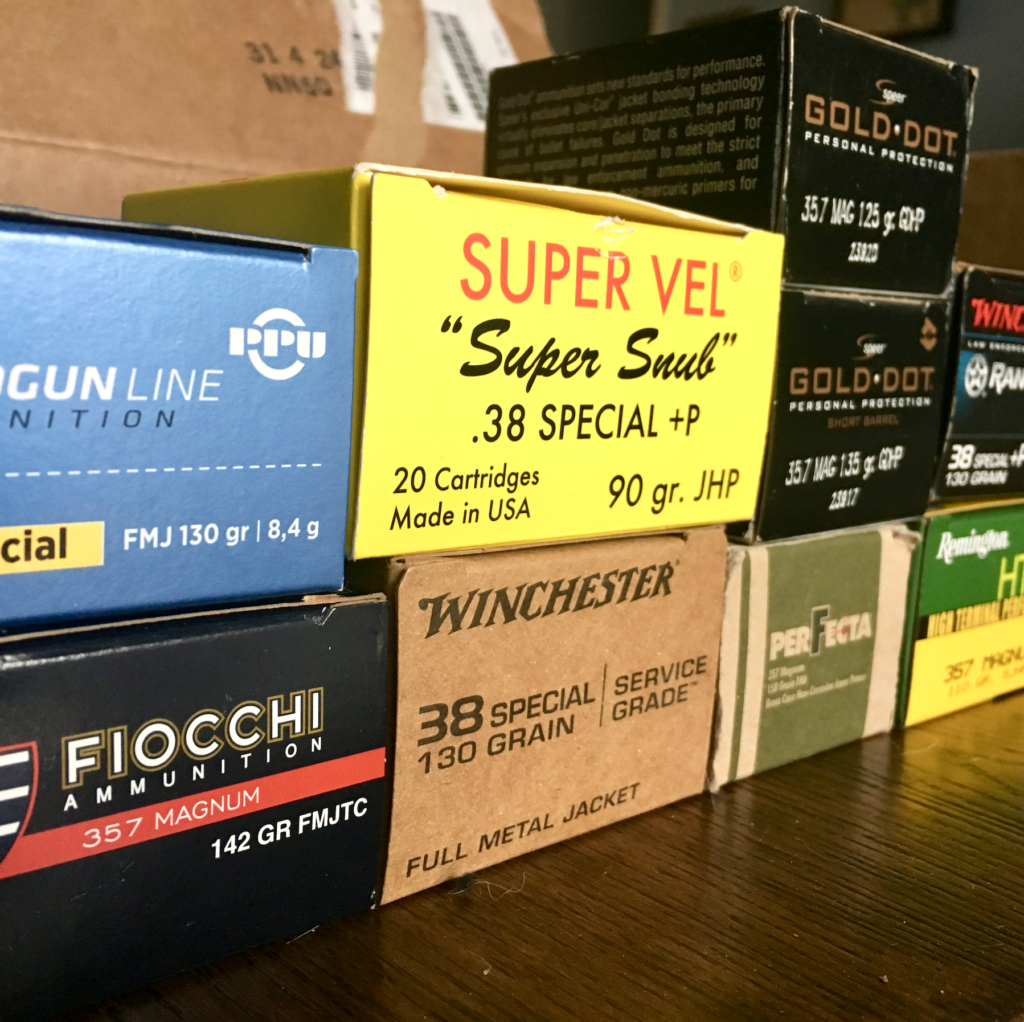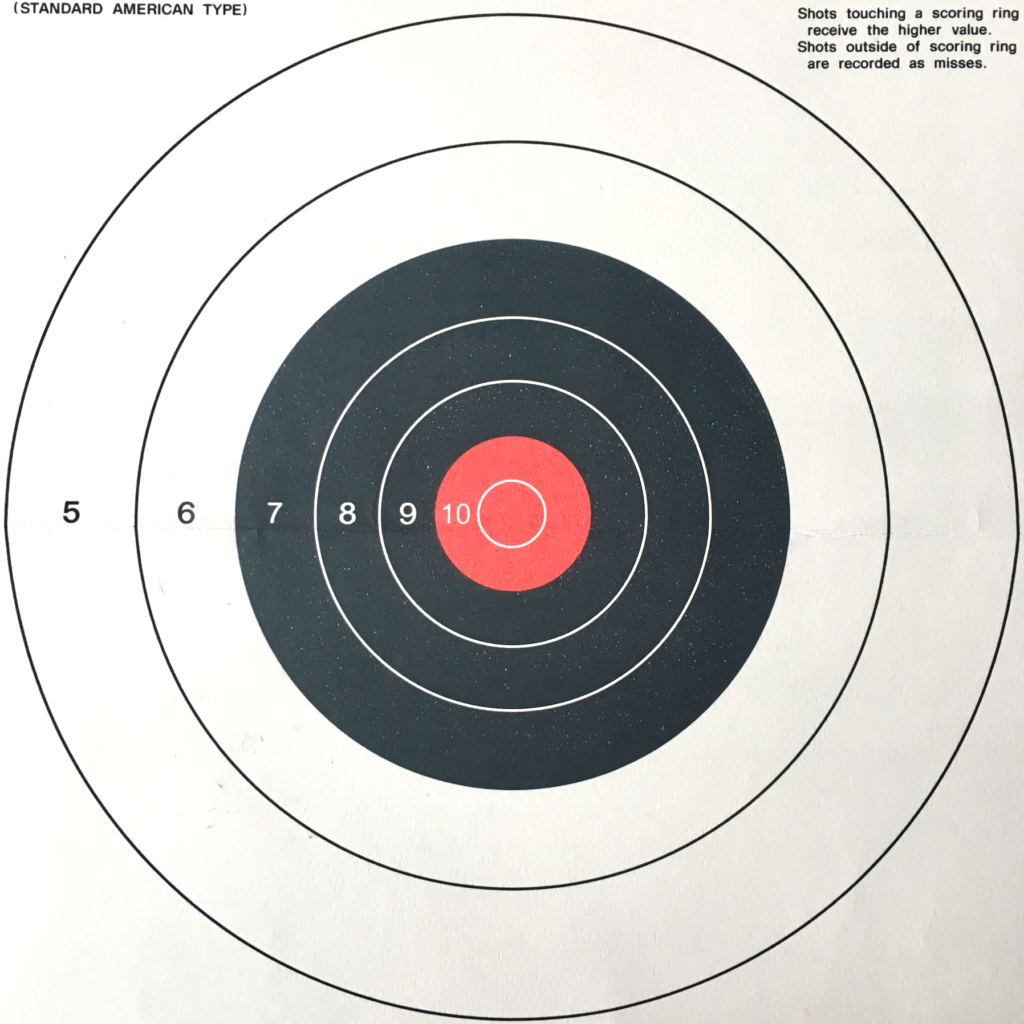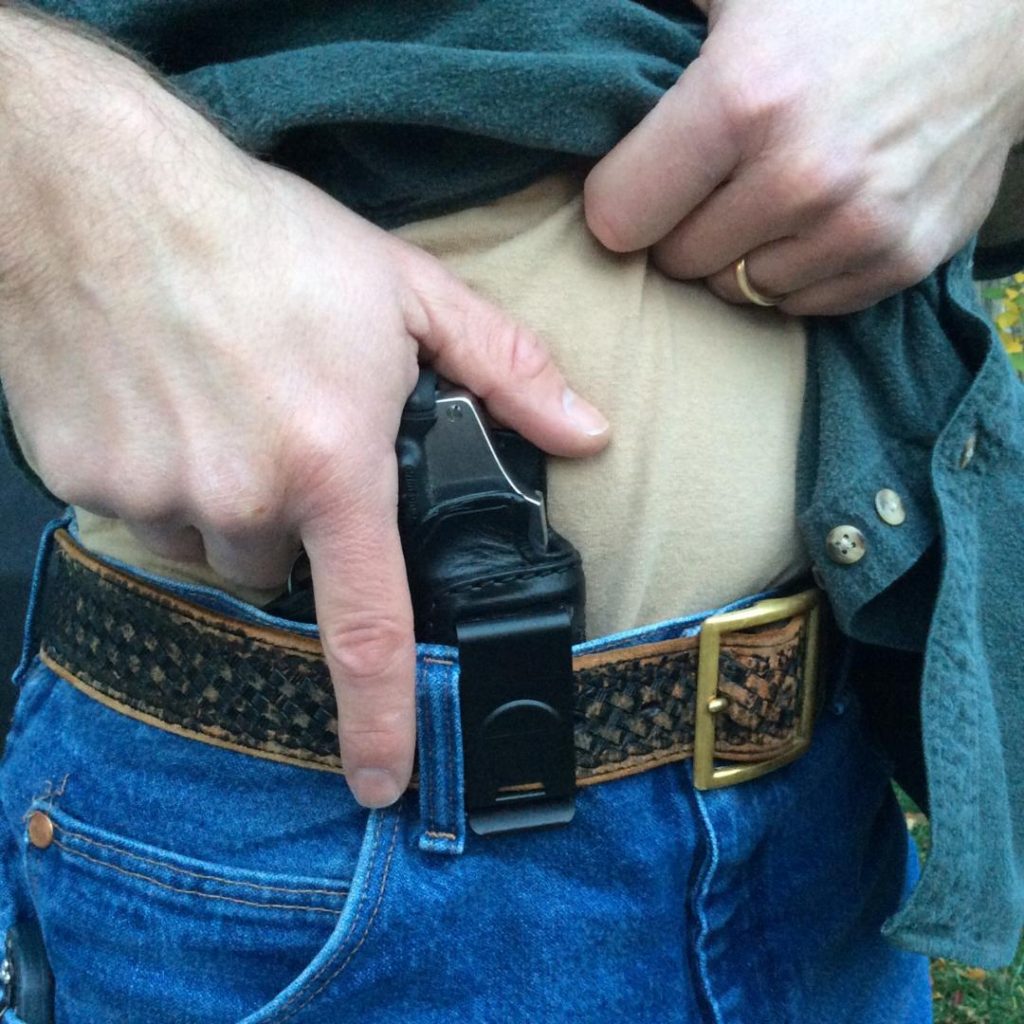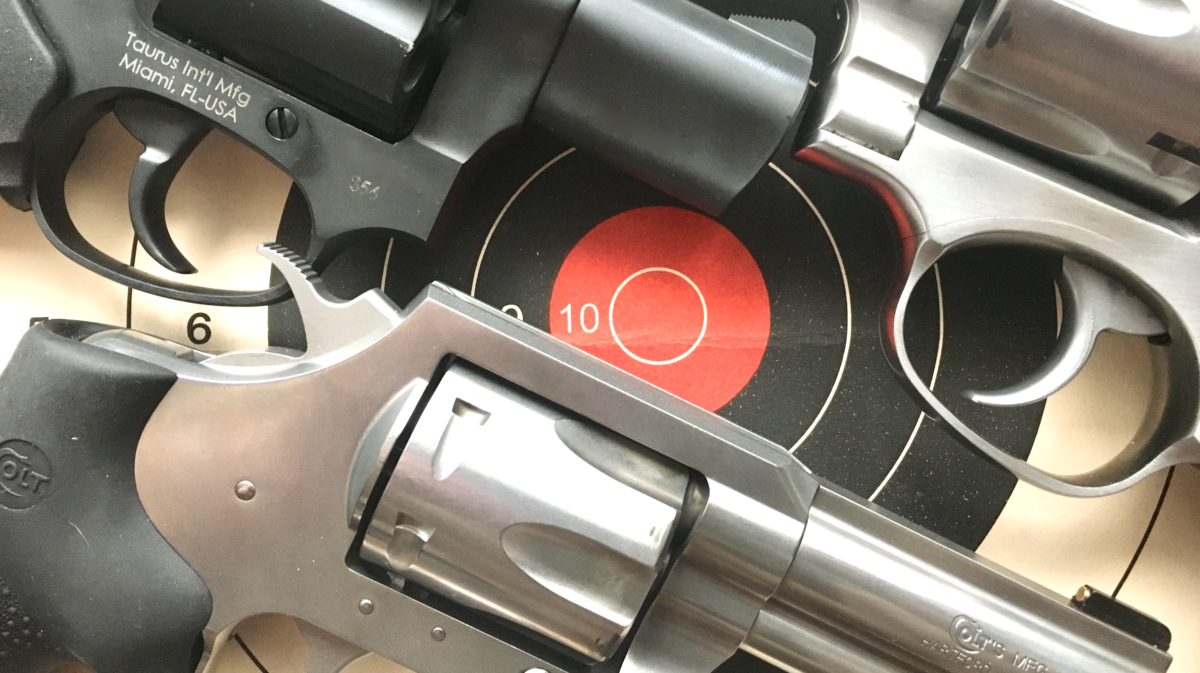Good news, guys: it’s raining guns on us here at RevolverGuy! Thanks to Mike’s hard work at SHOT (and since) I’ve two revolvers sitting here awaiting review, and another on the way. We’ve come a long way since the first T&E gun I was lucky enough to receive. With all these new guns coming in, we have worked to develop a Revolver Testing Standard Operating Procedure (RT-SOP).
The RG Revolver Testing Standard Operating Procedure
There are a couple of reasons for developing the RT-SOP. The first is fairness. Despite our attempts to remain unbiased, Mike and I have our preferences. We don’t want this to translate into unequal attention to the guns we review here. We’d like for the guns we test to be tested to a reasonably similar standard.
The second reason for this is cost, in both time and money. Sometimes I’m tempted to expend a lot more ammo and time on a gun that I really enjoy shooting. This could come at the expense of spending range time and ammo on something else. This can also unduly delay the publication of a review, and we know you guys are waiting for them. Having the RT-SOP can help us know when we’ve tested a gun “good enough” and when it’s time to write it up. That doesn’t mean we can’t shoot a gun more, just that we don’t have to.
Finally and most importantly, the RT-SOP is designed to prevent us from devolving into 100-round gun reviews. We want to really wring out the guns that are sent to this. We understand that you, the reader, may purchase firearms based on our recommendation and we want to provide you with an accurate assessment of how the gun holds up under hard use. That requires us to subject the gun to some hard use. RevolverGuy is committed to providing you with reviews you can trust.
RT-SOP: Function and Reliability
Round Count: Our goal is to fire at least 500 rounds, over at least three range sessions, through any revolver we test here. This number should reveal any problems in the gun. If a revolver is going to have mechanical problems, it is likely that those problems will be discovered within the first couple hundred rounds. Firing 500 rounds should also allow us to identify any serious ergonomic issues (blisters, hot spots, pinch points, cuts, bruises, etc.) that a lighter test might not tease out.

Ammunition Variety: We will attempt to fire tested revolvers with a variety of ammunition. This ammunition tested in a given firearm should represent the available power spectrum, i.e. .38 Special, .38 +P, and .357 Magnum. The distribution between heavy and light loads will be based on several factors: shooter comfort, cost, and intended use of the gun. For a very small .357 we will primarily shoot .38 Special ammunition. For a full sized revolver intended for hunting, we will probably fire more .357 than .38, again to align with the purpose of the gun.
We will also attempt to represent ammunition from at least three different manufacturers. While most ammunition fired through a given revolver will be inexpensive range ammunition, we will fire at least 100 rounds of field/defensive/duty-grade ammo.
Rt-SOP: Handling and Accuracy
Handling: We will fire the Dot Torture drill twice with each firearm that we review here. The first iteration will be fired within the first 100 rounds of our RT-SOP, and the second will be fired within the last 100 rounds. Both targets and scores will be presented for comparison in our Field Reports.
The Dot Torture drill is not the most comprehensive or challenging drill available, but we chose it for the following reasons. Dot Torture is indoor-range friendly. It does not require a shot timer, shooter movement, or unconventional shooting positions. It is extremely logistically friendly, too: all it requires is a target, three yards, 50 rounds, and 15 minutes. Despite all this it allows us to assess the gun’s performance from the holster, on multiple targets, over multiple-shot strings, during reloads, and while shooting strong- and weak-hand only.

Accuracy: We will handle accuracy testing differently according to the intended purpose of the firearm, and will basically subdivide them into “concealed carry” class and “field/duty class”.
Guns primarily intended for concealed carry will be accuracy-tested at 10 yards. At least three loads will be fired from this distance, from the offhand position, in double-action, at a NRA 25-yard Slow Fire (or similar) target. The same test will be conducted for field/duty-sized revolvers, but the distance will be increased to 25 yards. The groups from these tests will be presented in our final Field Report.
RT-SOP: Carrying
The focus of this blog is primarily on revolvers and their use in defensive roles. When we test a revolver that is intended for concealed carry, we will carry the firearm for at least 40 hours. If the gun is intended for field/duty use we may omit this section at our discretion.

RT-SOP: REporting
Sometimes firearms don’t work the way they’re intended to. As an example, during our work with the Kimber K6S, a member of the test team had a broken firing pin, which deserved some attention in our report.
Our approach to handling that situation was to be fair to both you and the manufacturer. You deserved a full disclosure and explanation of the problem, and the manufacturer deserved the opportunity to exercise their warranty and customer service processes, and to conduct an investigation. We told you that the firing pin broke, but also gave Kimber a chance to fix and address it.
It’s important to note that our involvement didn’t stop with reporting the problem. As enthusiasts and consumers, we want the industry and the products they make to improve, so we are committed to assisting with that goal. In the case of Kimber, we stayed in close contact to provide information and monitor their progress, and were the first to report about the upgraded firing pin design which resulted. By working collaboratively with Kimber, we now enjoy an improved product as consumers.
We will honestly report any failures or malfunctions, or any other issues that potential buyers should be aware of.
If we do experience a mechanical failure of a firearm during our test, we will contact the manufacturer. The manufacturer’s response will be reported to you, along with any corrective action that was taken. We will likely provide our assessment (“this was total fluke,” or “this seems to be a problem that ___ needs to address”) but we will present all the information so you can make your own decision. While our priority will always be you, the reader, we will also endeavor to treat manufacturers fairly and avoid engaging in gratuitous bashing.
the RT-SOP in a Nutshell
That’s a lot of writing. So here are the big bullet points that you can count on in a RevolverGuy Field Test:
- Function & Reliability Testing
- Minimum 500 rounds fired
- Minimum of three manufacturers
- Full power spectrum for caliber
- Minimum 100 rounds field/defensive/duty ammunition
- Basic Handling & Accuracy Testing
- 2x Dot Torture Drill (one within first 100 rounds, one within last 100 rounds)
- 3x Five-shot group, offhand, double-action group at 15 yards (concealed carry guns) or 25 yards (field or duty guns)
- Carrying
- Concealed carry of the firearms intended for concealed carry for at least 40 hours
“Field Test” Designation and Deviations from the RT-SOP
At times we may deviate from the revolver testing standard operating procedure. Reasons for this may vary. Situations that I can foresee doing this include guns that are extremely unpleasant to shoot. I doubt we’ll be putting 500 rounds through an ultra-light .44 Magnum. We may also opt to deviate from the SOP if ammunition is prohibitively expensive, or in instances where we have very limited access to a firearm (i.e. it is only on loan for a single range session). In some cases we may not be able to find three different loads due to availability issues (i.e. .327 Federal). We may not be able to carry a particular firearm because of holster availability.
This part is important: in the event that we choose or are forced to deviate from our revolver testing standard operating procedure, we will make it perfectly clear. Articles that meet the full revolver testing standard operating procedure will be entitled “Field Report” (i.e. S&W Model 60-15 Field Report).
If we are forced to deviate from the RT-SOP, the article in question will not be designated as a Field Report, and we will make it perfectly clear in the article that it was not tested to the full standard. We also reserve the right to release early “sneak peak” articles on new or noteworthy firearms but again, these will not be designated as Field Reports.
We have not followed this test protocol in the past, and it will only apply to new reviews that occur after publication date here.
the Bottom Line
Again, the RevolverGuy team is committed to providing you with reviews that you can trust. We hope that our Field Report Revolver Testing Standard Operating Procedures can formalize our gun reviews and make them go a bit above and beyond what other outlets may be providing. That doesn’t make us the go-to source for breaking news in the industry, but you can count on our Field Reports to be backed by, well, all of the above!
If we missed something – or there are specific elements of information you’d like to see in our field reports – please let us know in the comments.


I see a Taurus up top. News from recent owners is that the company renewed its lifetime warranty policy for original purchasers. Now let’s see how QC holds up for 500 rounds.
With their new guns, I’ve been very leery to recommend them to friends on a budget needing a HD gun, but cautious of buying a used gun.
Folks on forums glow about their Taurus wheelguns after 100 rounds, but that’s not enough of a test. It was, in fact, only after about 500 that I got a feel for my Kimber K6S, a gun with a far better reputation. So let us know how all the guns that rained down on you do! You have a “problem” that will keep you occupied for months.
I don’t want to give away all the surprises but yes – Taurus is one of the guns that we are reviewing.
I agree that 100 rounds isn’t enough to give more than initial impressions. I also realize that one gun might be different than another gun from the same line, but it’s what we can realistically do.
We will definitely keep you informed – in fact we’re thrilled to be able to get these reviews out to you guys!
Personally, I have yet to handle and/or shoot ANY Taurus firearm that I would stake my life on in a SHTF moment. Years ago I would do action smoothing jobs on the revolvers. Compared to the QC of even post-2000 S&W wheelguns, there was no comparison. The steel in the Taurus guns I worked on was noticeably softer than the S&W, and the interior machining was definitely not up to snuff.
Unless Taurus has gone through a radical overhaul of manufacturing quality, and quality control PLUS consistency, then it’s still a Ford Pinto with a service life measured in hundreds of rounds instead of tens of thousands.
Let’s try to keep the discussion pertinent to the article at hand.
Your comment does raise a valid point, however. Some guns may merit more than a five-hundred round test. I’m certainly open to that if there is sufficient interest in a specific gun. In fact I’d be happy to run a 10k “torture test” on just about anything.
However, this can/does incur significant cost on our end. With current testing protocol we’re going out-of-pocket approximately $400-500 for every gun we review, just at the 500 round mark. This includes transfer fees, range fees, ammunition, and in some cases, holsters.
We are looking at rolling out monetization plans sometime this year. That is where that money will go, and you guys will get some say in that.
I think your parameters for testing are right on target, forgive the pun. That is exactly what I want to see provided in gun reviews. I’ve sat through far too many extremely poor YouTube video reviews and came away with hardly any useable information. I’ve also read countless reviews of certain revolvers only to find the same very limited information in every review. I like the cut of your jib… keep up the good work!
Many thanks, Ian! We’ll do our best!
Justin,
I have enjoyed you reviews in the past and found them fair and informative. Your new protocol should make them even more so.
Thanks for taking your time to share these reviews with us!
Thanks, Jim! FYI there’s a Greg Ellifritz snubby class in Ohio this October. Ky and I would love to see you there!
Justin,
Thanks for the heads up!
I’ll look it up.
I am curious as to why no testing at 25 yards using a bag rest of some sort and maybe in single action, for revolvers that have it, in the field and duty class? I think that some indication of probable inherent accuracy is of interest for these. Of course I understand that something like that probably is less convenient, depending on range facilities and time, money and effort require a few lines to be drawn.
On the whole, it looks like a reasonable set of procedures for testing, certainly more extensive than the more usual evaluations. I eagerly await the results. Unleash the hounds! Oops, I meant “unleash the rounds!”
Chris,
I won’t totally rule that out. However, this isn’t possible on some ranges and due to my travel schedule I’m not always available to shoot at my home range. We wanted a protocol that was as universally possible to implement as possible.
We have “released the rounds(!)” and will be online with our next review very soon!
Justin
Sounds like an awful lot of shooting, I suppose I’ll offer my services and shoot any of those revolvers for y’all 😉
I love the professionalism of his site and the consistency of the articles, I am looking forward to what y’all have to offer.
P.S.- if anyone knows of any revolver classes in New Mexico I’d love to know about it.
Ryan,
Many thanks! We may take you up on that one of these days!
I don’t know about New Mexico, but I know Grant teaches a course or two per year in Phoenix – that’s about as close as I’m aware of.
Best,
Justin
Any plans to review any .327 federal magnum revolvers in the near future? After watching Chris with Lucky Gunner’s last couple videos on it I’m definitely intrigued. Especially since you can get an extra round in some of those small snubbies like the SP101 and LCR.
I have really enjoyed your reviews so far and am looking forward to the new format and new wheel guns! Keep up the good work.
Nothing definitive yet, but I’ve been wanting to mess around with one for a while. If we can talk Ruger into sending us one (probably an SP101) I may put that on the agenda for this fall.
Thanks for letting us know what you’d like to see!
Justin